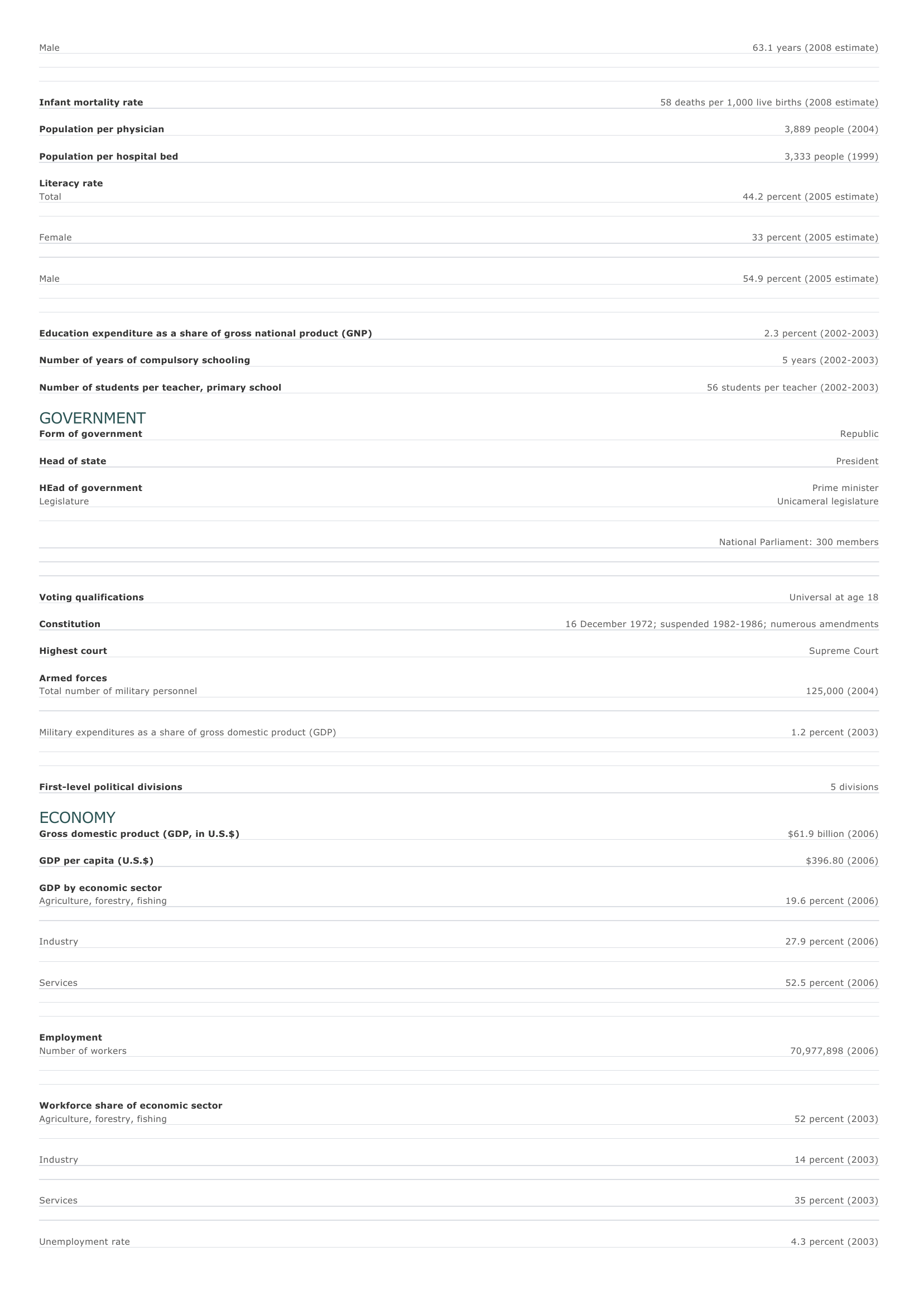
Bangladesh Facts and Figures. BASIC FACTS Official name Capital Area People's Republic of Bangladesh Dhaka 147,570 sq km 56,977 sq mi PEOPLE Population 153,546,900 (2008 estimate) Population growth Population growth rate 2.02 percent (2008 estimate) Projected population in 2025 204,538,715 (2025 estimate) Projected population in 2050 279,955,405 (2050 estimate) Population density 1,147 persons per sq km (2008 estimate) 2,970 persons per sq mi (2008 estimate) Urban/rural distribution Share urban 25 percent (2005 estimate) Share rural 75 percent (2005 estimate) Largest cities, with population D haka 5,378,023 (2006 estimate) Chittagong 1,360,000 (2007 estimate) K hulna 546,000 (2007 estimate) R ?jsh? hi 324,532 (1991) N? r ?yanganj 268,952 (1991) Ethnic groups Bengali O ther 98 percent 2 percent Languages Bangla (official), Urdu, English Religious affiliations Muslim 86 percent Hindu 12 percent O ther 2 percent HEALTH AND EDUCATION Life expectancy Total 63.2 years (2008 estimate) Female 63.3 years (2008 estimate) Male Infant mortality rate 63.1 years (2008 estimate) 58 deaths per 1,000 live births (2008 estimate) Population per physician 3,889 people (2004) Population per hospital bed 3,333 people (1999) Literacy rate Total Female Male Education expenditure as a share of gross national product (GNP) Number of years of compulsory schooling Number of students per teacher, primary school 44.2 percent (2005 estimate) 33 percent (2005 estimate) 54.9 percent (2005 estimate) 2.3 percent (2002-2003) 5 years (2002-2003) 56 students per teacher (2002-2003) GOVERNMENT Form of government Head of state HEad of government Legislature Republic President Prime minister Unicameral legislature National Parliament: 300 members Voting qualifications Constitution Highest court Universal at age 18 16 December 1972; suspended 1982-1986; numerous amendments Supreme Court Armed forces Total number of military personnel Military expenditures as a share of gross domestic product (GDP) First-level political divisions 125,000 (2004) 1.2 percent (2003) 5 divisions ECONOMY Gross domestic product (GDP, in U.S.$) GDP per capita (U.S.$) $61.9 billion (2006) $396.80 (2006) GDP by economic sector Agriculture, forestry, fishing 19.6 percent (2006) I ndustry 27.9 percent (2006) Services 52.5 percent (2006) Employment Number of workers 70,977,898 (2006) Workforce share of economic sector Agriculture, forestry, fishing 52 percent (2003) I ndustry 14 percent (2003) Services 35 percent (2003) Unemployment rate 4.3 percent (2003) National budget (U.S.$) Total revenue 4,898 million (2004) Total expenditure 5,575 million (2004) Monetary unit 1 taka (Tk), consisting of 100 paisa Major trade partners for exports United States, Germany, United Kingdom, France, Italy Major trade partners for imports India, China, Singapore, Japan, Hong Kong SAR ENERGY, COMMUNICATIONS, AND TRANSPORTATION Electricity production Electricity from thermal sources Electricity from hydroelectric sources 93.65 percent (2003 estimate) 6.35 percent (2003 estimate) Electricity from nuclear sources 0 percent (2003 estimate) Electricity from geothermal, solar, and wind sources 0 percent (2003 estimate) Number of radios per 1,000 people 50 (1997) Number of telephones per 1,000 people 8 (2005) Number of televisions per 1,000 people 7.4 (2000 estimate) Number of Internet hosts per 10,000 people 0 (2000) Daily newspaper circulation per 1,000 people 9 (1996) Number of motor vehicles per 1,000 people Paved road as a share of total roads 1.1 (1999) 10 percent (2004) SOURCES Basic Facts and People sections Area data are from the statistical bureaus of individual countries. Population, population growth rate, and population projections are from the United States Census Bureau, International Programs Center, International Data Base (IDB) (www.census.gov). Urban and rural population data are from the Food and Agriculture Organization (FAO) of the United Nations (UN), FAOSTAT database (www.fao.org). Largest cities population data and political divisions data are from the statistical bureaus of individual countries. Ethnic divisions and religion data are largely from the latest Central Intelligence Agency (CIA) World Factbook and from various country censuses and reports. Language data are largely from the Ethnologue, Languages of the World, Summer Institute of Linguistics International (www.sil.org). Health and Education section Life expectancy and infant mortality data are from the United States Census Bureau, International Programs Center, International database (IDB) (www.census.gov). Population per physician and population per hospital bed data are from the World Health Organization (WHO) (www.who.int). Education data are from the United Nations Educational, Scientific and Cultural Organization (UNESCO) database (www.unesco.org). Government section Government, independence, legislature, constitution, highest court, and voting qualifications data are largely from various government Web sites, the latest Europa World Yearbook, and the latest Central Intelligence Agency (CIA) World Factbook. The armed forces data is from Military Balance. Economy section Gross domestic product (GDP), GDP per capita, GDP by economic sectors, employment, and national budget data are from the World Bank database (www.worldbank.org). Monetary unit, agriculture, mining, manufacturing, exports, imports, and major trade partner information is from the statistical bureaus of individual countries, latest Europa World Yearbook, and various United Nations and International Monetary Fund (IMF) publications. Energy, Communication, and Transportation section Electricity information is from the Energy Information Administration (EIA) database (www.eia.doe.gov). Radio, telephone, television, and newspaper information is from the United Nations Educational, Scientific and Cultural Organization (UNESCO) database (www.unesco.org). Internet hosts, motor vehicles, and road data are from the World Bank database (www.worldbank.org). Note Figures may not total 100 percent due to rounding. Microsoft ® Encarta ® 2009. © 1993-2008 Microsoft Corporation. All rights reserved.








